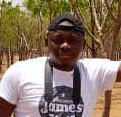
Despite recent concerns from the UN desertification president about potential delays in achieving the 2030 completion goal of the Great Green Wall (GGW) due to financial constraints and the absence of a centralized monitoring strategy, optimism remains high among young people across the Sahelian Belt—from Djibouti to Senegal. They remain steadfast in their commitment to restore degraded ecosystems on the Sahara Desert’s edge, mitigate escalating drought, and ensure food security.
A recent webinar, which drew nearly 550 participants, organized by the Centre for International Forestry Research and World Agroforestry (CIFOR-ICRAF) under the European Union-funded Knowledge for Great Green Wall Action (K4GGWA), emphasized harnessing youth power for GGW and climate action.
The Sahel stands out as one of the world’s most youthful regions, with 64.5% of its population under 25—approximately 320 million young people. Consequently, they play a pivotal role in ensuring their own survival amidst complex environmental, security, and political challenges. The GGW initiative serves as a catalyst—a continental effort led by Africans—to reclaim degraded land through a mosaic of interventions spanning approximately 8,000 kilometers from Senegal to Djibouti.
During the webinar, Gilles Amadou Ouédraogo, Program Management Officer for the GGW Accelerator at the UN Convention to Combat Desertification (UNCCD), highlighted the vibrant momentum among youth and underscored their critical role in climate change. He expressed a desire to sustain and enhance youth involvement, including influencing school curricula to instill early environmental awareness. “I don’t think the point is to ‘include youth’ in the Great Green Wall. Youth are the Great Green Wall,” he said.
Small actions, big impact
A poll taken during the webinar revealed that youth engagement in land restoration and climate action within the GGW is deemed “High” by the majority of participants. On the ground, this commitment is visible through local initiatives in adaptation, mitigation, awareness campaigns, and advocacy—several of which were presented to the floor during the session.
In Mali, Sinakoye Sakale Traoré, Director and Founder of Mamali Moringa, champions eco-friendly moringa cultivation, processing it into powder, herbal teas, and cookies while educating local communities on its nutritional benefits to combat malnutrition. The enterprise has planted 10,000 moringa trees, created nine direct jobs, and trained 1,000 farmers in Mali and Burkina Faso, thus curbing deforestation.
“I hope to make moringa an industry which creates hundreds of jobs in Mali, in rural and urban areas,” she said. “I also want to develop a new agricultural model and store carbon to combat climate change.”
In Nigeria, Temitope Abisoye of FAO’s Forestry Youth Group engages in forest education and community-based agroforestry and tree-planting initiatives. In addition to tree tagging and building community livelihood projects, she has taught young people to bird watch as a means of connecting with nature and keeping track of the continent’s biodiversity.
She said it has not been an easy task so far, but her motivation has been to understand the challenges and believe in the impact. “Doing restoration projects in Africa means understanding people’s needs,” she said. “You can’t preach conservation and restoration to people who are hungry.”
In Ethiopia, Helina Teklu—founder of the social enterprise Seed Balls—is using a creative method of seed dispersal to restore degraded lands, increase vegetation cover and promote sustainable agriculture. The technique involves small balls made of seeds, clay and compost which are scattered across the land, allowing the seeds to germinate into plants and enhancing their chances of survival and growth. “Change begins at home,” she said. “In conservation, you have to start where you are before you can radiate it out to society.”
Tackling challenges head-on
Despite these success stories, participants disclosed a panoply of challenges hindering their actions, notably: lack of sufficient funding for youth-related activities, inadequate information and knowledge regarding capacity building and funding opportunities, and the absence of a harmonized framework and plan for youth contribution to the GGW. They also cited difficulties accessing land, community resistance, a lack of technical expertise, logistical challenges, unhealthy competition among local NGOs, unclear policy and a lack of coordination among government ministries, among other things.
Nisreen Elsaim, Chair of the Sudan Youth Organization for Climate Change and 2018 Junior Negotiator with the African group of negotiators on climate change, noted that it is very difficult to make progress without stability. “Besides political stability, community stability is paramount,” she said.
Musa Ibrahim, founder of Voice for Environment Nigeria and a youth champion of the National Agency for GGW, said it is crucial to provide young people with learning and networking opportunities, and to channel their skills towards the advancement of the GGW.
A Land Hero of the United Nations Convention to Combat Desertification (UNCCD), who developed a youth volunteer programme for the GGW and has travelled over 3,000 km by road across three Sahelian countries to promote the initiative, Ibrahim shared his belief that more active engagement of the youth could bring new momentum to the GGW.
“Personally, as a young person, I believe that anything for young people without young people is not for young people or is against young people,” he said. “Today, the severity of land degradation cuts across continents, of which Africa is also facing the brunt.” Despite these challenges, “young people should never give up,” he urged, “but should remain enthusiastic and confident that there is always reward for a job well done.”
We want you to share Forests News content, which is licensed under Creative Commons Attribution-NonCommercial-ShareAlike 4.0 International (CC BY-NC-SA 4.0). This means you are free to redistribute our material for non-commercial purposes. All we ask is that you give Forests News appropriate credit and link to the original Forests News content, indicate if changes were made, and distribute your contributions under the same Creative Commons license. You must notify Forests News if you repost, reprint or reuse our materials by contacting forestsnews@cifor-icraf.org.












